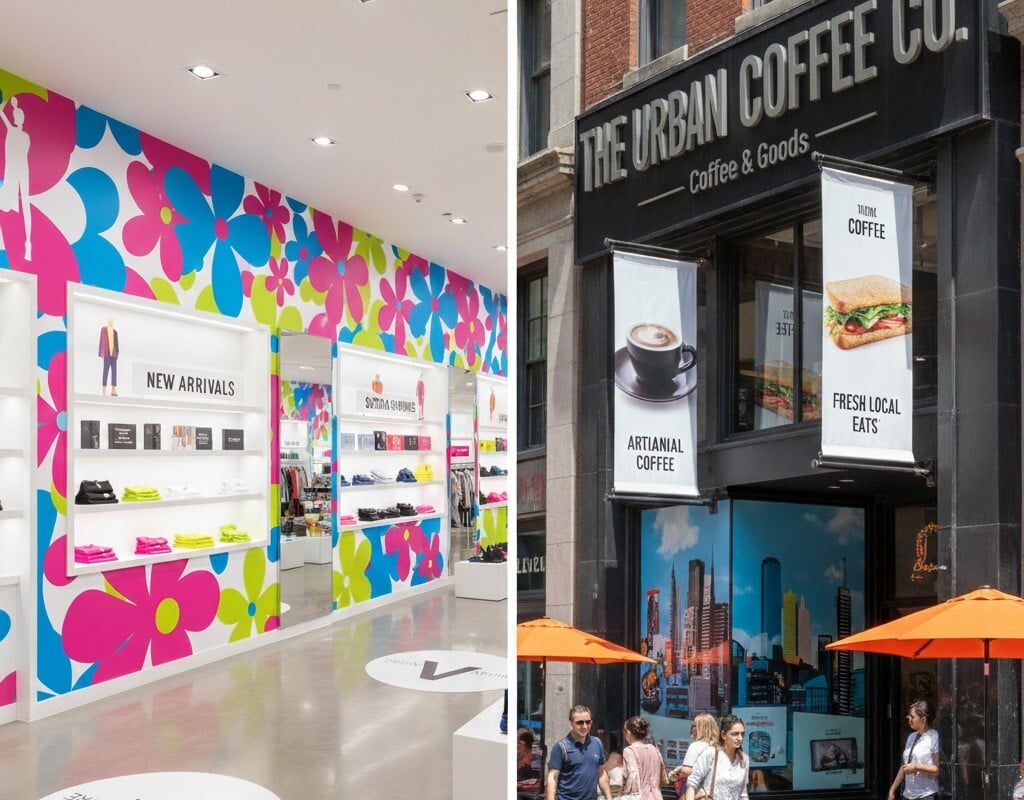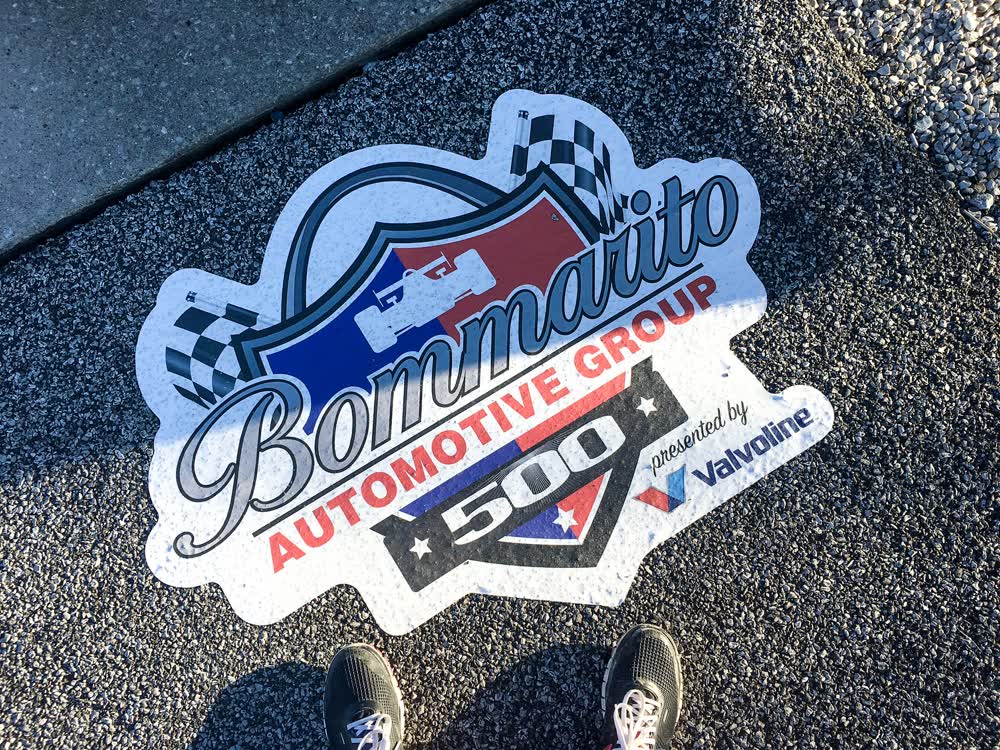Maximizing Sales with Retail Graphics and Visual Merchandising
It may surprise you that a retail store's visual appearance has a significant impact on sales. Adding well-designed graphics and signage can elevate...
7 min read
Craftsmen Industries Nov 6, 2025 1:15:33 AM

Indoor and outdoor graphics serve the same purpose, enhancing brand visibility and customer engagement. However, they differ significantly in design, material selection, and durability due to the unique environmental conditions they face.
According to a study published in a journal on signage and wayfinding, signage is a vital part of marketing communication, influencing purchasing behaviour and customer perceptions.
Outdoor signage, for example, is more influential than internet ads and radio for conveying new product information, highlighting its effectiveness in drawing attention and creating lasting impressions.
In this blog, we will explore the key differences between indoor and outdoor graphics, focusing on design considerations, materials, durability, and maintenance requirements. Understanding these distinctions will help you choose the right graphics for your business, ensuring maximum impact and longevity.
When designing graphics for different environments, it's crucial to consider how the setting, visibility, and customer interaction influence the effectiveness of the signage. Indoor and outdoor graphics differ significantly in their design requirements to meet these unique challenges.
Indoor signage is designed to create a visually immersive and brand-focused environment.

Outdoor signage must withstand environmental conditions and attract attention from a distance.

According to Biagriculture, ADA-compliant signs and outdoor signage can significantly improve brand visibility and customer experience.
Businesses with clear and engaging signage have reported improved customer satisfaction by 30%, demonstrating how effective signage can enhance a customer's interaction with a brand.
Customization allows indoor signage to blend seamlessly with the interior design of a space, enhancing the aesthetic experience and reinforcing brand identity, making it more memorable and engaging for customers.
Selecting the right materials for indoor and outdoor graphics is essential for ensuring longevity, appearance, and performance. The choice of materials affects both the durability and aesthetic of the graphics, making it crucial to understand the unique needs of each environment.
Indoor graphics use materials suited for controlled conditions that enhance aesthetics without needing extreme durability.
Outdoor graphics require materials that resist environmental stresses like sunlight, moisture, and pollution.
A study in ResearchGate found that climate change is increasingly affecting the durability of facade materials due to exposure to diverse weather conditions.
This emphasizes the need for weather-resistant and durable materials for outdoor signage, ensuring it withstands environmental stresses like temperature fluctuations, UV exposure, and humidity.
Outdoor signage needs to withstand various environmental factors like weather, UV rays, and dirt.
Selecting the right materials, such as weather-resistant vinyl and UV coatings, ensures that the signage remains readable and vibrant for an extended period, reducing the need for frequent replacements.
The durability of indoor and outdoor graphics is heavily influenced by their exposure to environmental factors.
Understanding the conditions each type of signage will face is key to ensuring its longevity and performance over time.
Indoor graphics experience minimal environmental stress.
Outdoor graphics are exposed to multiple environmental challenges.
When choosing between indoor and outdoor graphics, businesses need to consider the overall costs, including production, installation, and maintenance. Balancing quality with budget requirements is key to ensuring that the signage lasts and continues to meet its purpose over time.
Indoor graphics are generally less expensive because the environment is controlled, reducing the need for highly durable materials. These cost considerations include:
Outdoor graphics require durable, weather-resistant materials and specialized installation, which increases overall costs. This section explains the factors contributing to higher expenses:
Outdoor graphics require more durable, weather-resistant materials, such as vinyl or aluminum, which can withstand environmental elements like UV rays, rain, and wind.
These materials, along with the specialized mounting and higher maintenance needs, contribute to the higher overall costs of outdoor signage.
Proper maintenance is critical for ensuring the longevity and effectiveness of both indoor and outdoor graphics.
The level of exposure to environmental factors determines how much maintenance is required for each type of signage.
Indoor signage requires minimal upkeep, but regular care ensures longevity and clarity:
Outdoor signage requires more frequent attention due to exposure to weather, dirt, and UV rays:
According to Research, the longevity of both indoor and outdoor signage is greatly impacted by regular maintenance.
While indoor graphics generally require less upkeep, outdoor signage faces harsher conditions such as UV rays, humidity, and extreme temperatures, which can lead to faster wear and tear.
The study highlights that investing in high-quality, weather-resistant materials and protective coatings can significantly reduce maintenance costs in the long run.
Investing in high-quality, weather-resistant materials such as vinyl, aluminum, and acrylic, along with applying protective coatings like UV-resistant laminates, can minimize the need for frequent repairs and replacements, thereby reducing long-term maintenance costs.
Selecting between indoor and outdoor graphics depends on the environment, purpose, and durability. Indoor graphics allow for intricate designs and cost-effective materials, while outdoor graphics must be durable, weather-resistant, and eye-catching.
Both are essential for brand visibility and customer engagement. Understanding the differences in design, materials, durability, and maintenance will help you make an informed decision.
At Craftsmen Industries, we offer custom-designed graphics for both indoor and outdoor spaces. Whether enhancing your retail environment or creating impactful outdoor signage, our team will help you choose the right materials and designs for your business.
Contact us today to discuss how we can bring your brand to life with high-quality graphics.
Indoor graphics are designed for controlled environments, often focusing on aesthetics and branding. Outdoor graphics are built to withstand weather elements and are designed to be more visible and durable.
Outdoor graphics face harsh environmental conditions, such as UV rays, rain, and wind. Choosing weather-resistant materials ensures that the graphics maintain their appearance and effectiveness over time.
Outdoor graphics generally need to be replaced more frequently than indoor graphics due to exposure to the elements. The lifespan depends on the materials used, but regular maintenance can extend the life of the signage.
While some materials can be used for both, outdoor graphics typically require more durable, weather-resistant materials like vinyl or aluminum. Indoor graphics can be made from lighter, less durable materials like paper or fabric.
The cost of outdoor graphics is influenced by material selection, size, installation requirements, and maintenance needs. Outdoor graphics require more durable materials and more expensive installations, increasing their overall cost.

It may surprise you that a retail store's visual appearance has a significant impact on sales. Adding well-designed graphics and signage can elevate...

Is your brand getting geared up for the holiday season, but unsure of how to best market yourself in our new normal? For many retail brands, this...

If I asked you to tell me about the last piece of signage you saw in a store, how much would you remember? Would you be able to recall the name of...